Port Vauban in Antibes, the biggest yacht marina in Europe, is brilliantly placed between Nice and Cannes on the French Riviera.
For other France cruise destinations check out our Mediterranean Cruise Ports in France page.
The cruise terminal is only a 10-minute stroll from the old town, and you can easily get there from Nice Airport (15km away) by shuttle bus, train or taxi.
The port has all the basics sorted – Wi-Fi, places to exchange money, cafés, and it’s wheelchair-friendly.
You can leave your car at the main port car park for £20 a day, or save a bit by parking at Avenue de Verdun for £15.
Want the best time here? Come between May and October when the Mediterranean weather‘s lovely and there’s plenty going on with local festivals.
This swanky French port has loads more to it than first meets the eye.
Where is The Port Located?
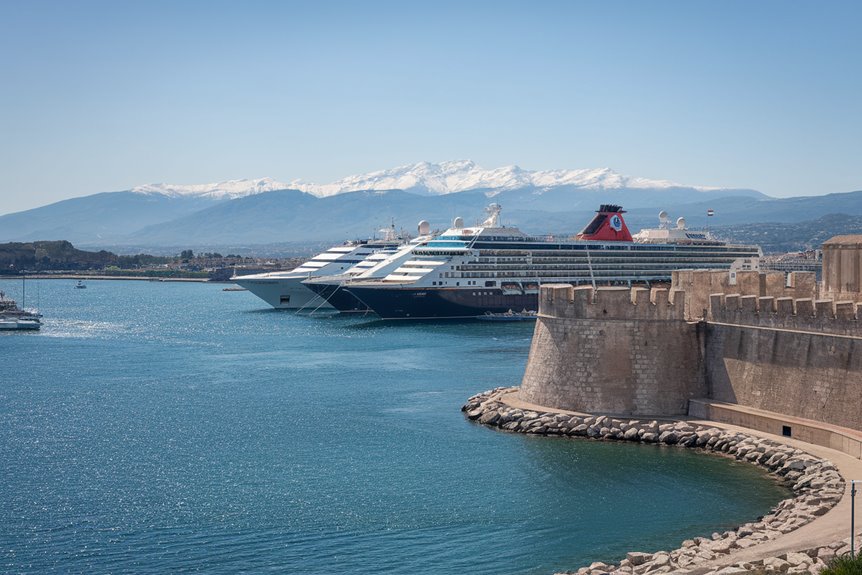
The Port of Antibes sits along France’s gorgeous Côte d’Azur, between Nice and Cannes. You’ll spot the International Port at Port Vauban – Europe’s largest yacht marina – right at the bottom of the old town’s 16th-century ramparts. It’s about 13 miles southwest of Nice and 7 miles northeast of Cannes.
If you come by cruise ship, you’ll pull into the newer commercial harbour section, which has space for ships up to 230 metres long. You can find the port at coordinates 43°35’N 7°08’E, and it’s dead easy to get to from the A8 motorway. From where the cruise ships dock, you can walk to Antibes’ historic centre in 10 minutes, and it’s roughly 15 minutes to the brilliant Cap d’Antibes peninsula.
Map of Antibes Cruise Ship Port
How to get to the port, by air, train, road
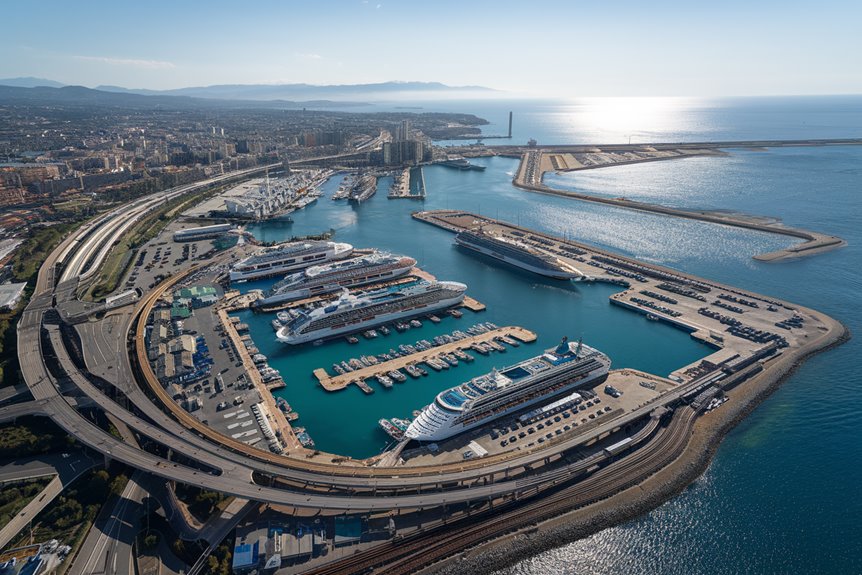
Getting to Antibes port is simple with great transport links across the Côte d’Azur. Nice Côte d’Azur Airport is 15km away, with regular shuttle buses and taxis to Antibes. If you’re coming by train, Antibes Railway Station is a 10-minute walk from the port, with connections to major cities in France and Italy. By car, head for the port via the A8 motorway – you’ll see signs pointing to Port Vauban.
- Catch shuttle bus #250 from Nice Airport Terminal 1 or 2 straight to Antibes (£10 per person)
- Get a TGV train to Antibes from Paris (5.5 hours) or Milan (5 hours) through SNCF
- When driving, follow signs to “Port Vauban” or “Port d’Antibes” – you can park at the port entrance (paid parking)
Port Parking Options
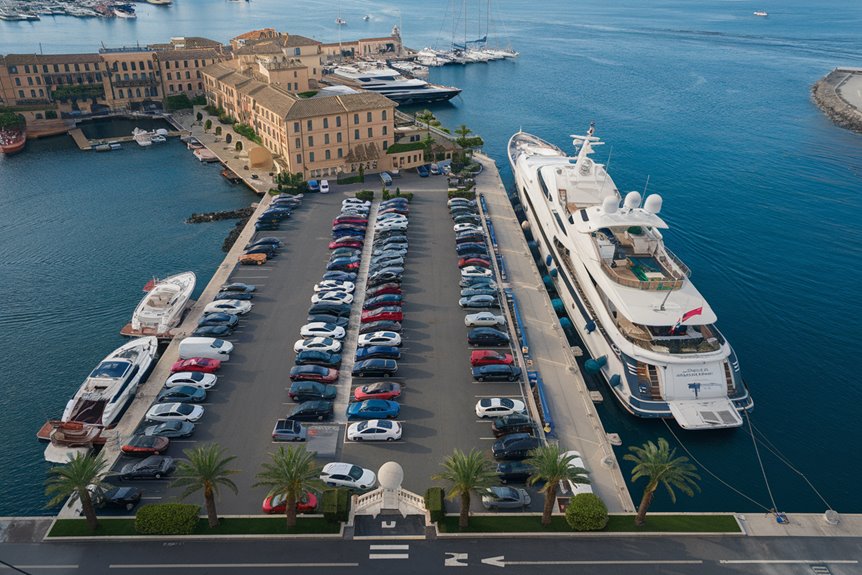
Around Port Vauban, there are plenty of safe places to park for different budgets and lengths of stay. The main port car park has covered spots for £20 per day, with weekly rates at £112. You’ll need to book ahead during the busy months from June to September.
If you want to save money, the open-air car park on Avenue de Verdun costs £15 daily and runs a free shuttle bus to the cruise terminal. For stays longer than a week, try the long-term parking at Pré des Pêcheurs, with monthly rates starting from £180.
Street parking near the port has a strict 4-hour limit and wardens are quite keen. You can pay at all car parks using credit cards or the EasyPark mobile app, which takes various currencies.
Local Transport & Transfers
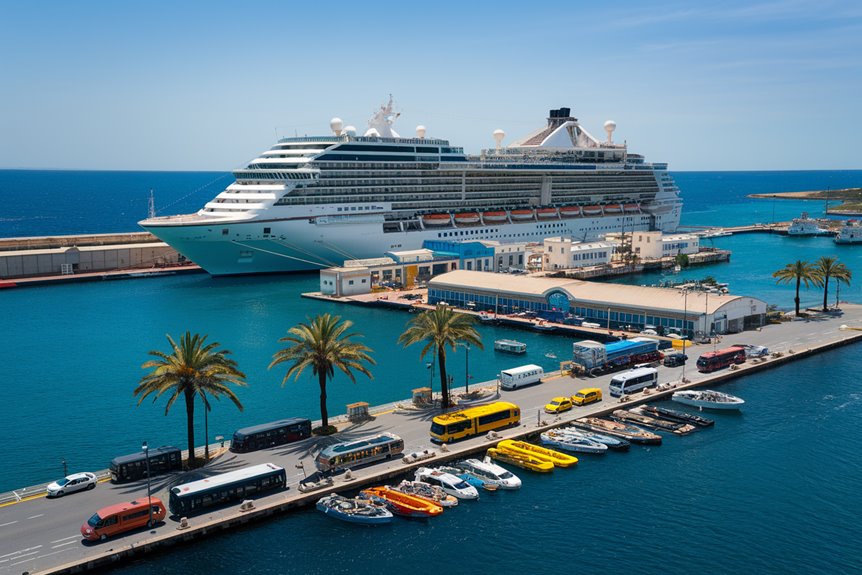
Getting to Antibes’ cruise terminal is straightforward, with several transport options available. The local bus network links the port with key spots – Line 200 runs between Nice and Cannes, stopping regularly in Antibes. If you’re coming from Nice Airport, there’s a handy express shuttle running every half hour during the busy season.
- You’ll find taxis at marked stands across Antibes. A ride from the town centre to the port typically costs £13-17
- The train station sits just 1.2 km from the cruise terminal, with good connections to other French Riviera towns
- Want a door-to-door service? Book a private shuttle online – they’ll pick you up from your hotel or the airport and take you straight to your ship
Port Terminal Facilities
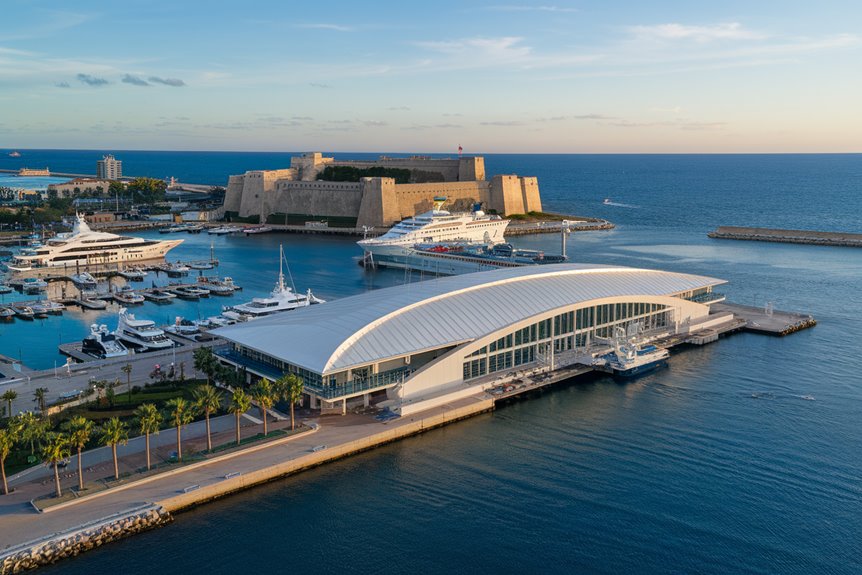
The Port Antibes terminal keeps things simple but gets the job done with its practical layout. Inside the main building, you’ll spot toilets, tourist info stands and a modest seating area. There’s free Wi-Fi across the terminal, though it tends to go a bit wonky when it’s busy.
You can sort out your money at the currency exchange or cash point, and there’s a little café for coffee and basic snacks. Security checks everyone at the entrance – remember to bring your cruise papers and passport. While you won’t find any proper shops inside, there are storage lockers handy if you fancy a wander around Antibes before your ship leaves. The terminal’s wheelchair-friendly and has basic medical help if needed.
Things to Do Before Your Cruise in a Day

Antibes’ Old Town is brilliantly compact, making it ideal for a day before your cruise. You can see the best bits of this lovely French Riviera town starting at the 16th-century Fort Carré, then wandering through the Provençal market where locals sell fresh fruit, veg and regional treats. The Picasso Museum is a must-see, sitting inside the Château Grimaldi where the famous artist lived and painted.
- Pop down to Port Vauban, Europe’s largest yacht harbour, to gawk at posh boats and grab lunch by the water
- Take in stunning Mediterranean views from the old ramparts – perfect for photos
- Have a proper look around the star-shaped Fort Carré, which once held Napoleon Bonaparte as a prisoner, to learn about the town’s past
Walks near the port
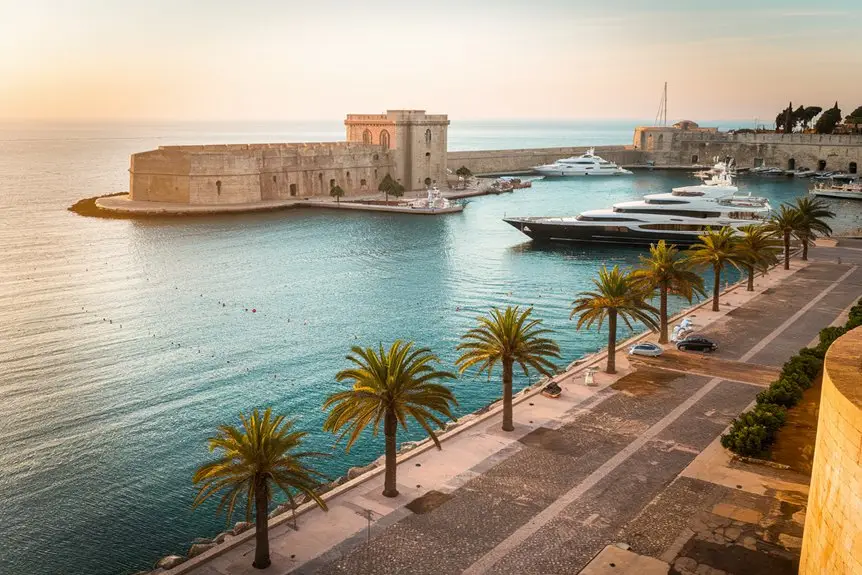
Nice walks around Port Vauban make it simple to get to all of Antibes’ best bits, with clear paths that run along the harbour and old city walls.
From where the cruise ships dock, you can wander along the waterfront past fancy yachts and local fishing boats until you reach Fort Carré, built in the 1500s. Walk on the stone path along the ancient walls for brilliant views of the Mediterranean Sea and the Alps far away.
Go south by the walls to get to the Old Town, where you can meander through the little streets of Vieil Antibes. The path goes on to the Picasso Museum and the lively Marché Provençal. If you fancy a longer walk, take the seaside path to Juan-les-Pins, a lovely beach town about 30 minutes on foot from the port.
Dining and Shopping
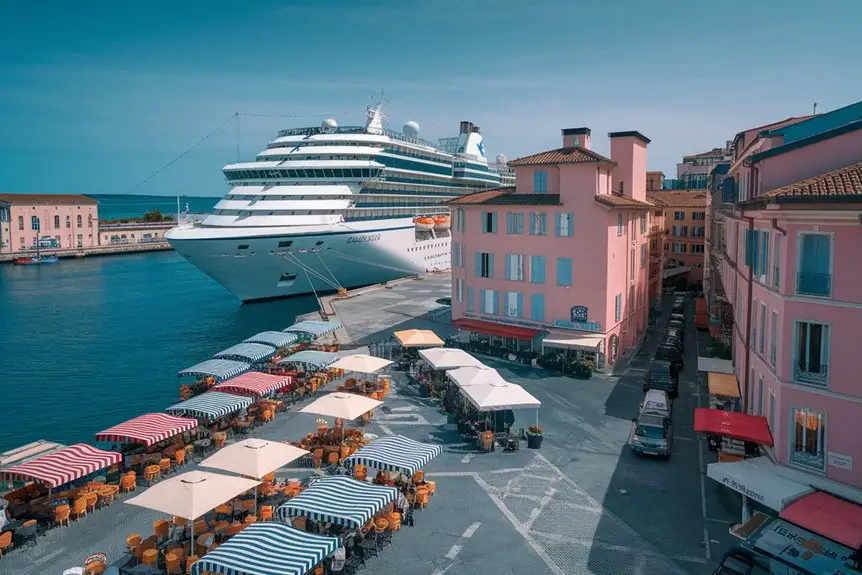
The port area of Antibes has brilliant places to eat and shop, all within a short walk. You’ll spot lovely seafood restaurants along Quai des Pêcheurs, where you can find fresh Mediterranean dishes and local favourites like bouillabaisse. The small streets behind the port are full of boutique shops selling Provençal items, handmade goods, and stylish clothes.
- Pop into the covered Marché Provençal in the morning for fresh produce, local cheeses, and proper French souvenirs
- The waterfront restaurants near Place du Safranier give you amazing views of luxury yachts while you eat
- Wander along Rue de la République for posh boutiques, jewellery stores, and traditional French fashion
The evening is particularly nice when restaurants put tables outside – perfect for watching the world go by with a glass of regional wine and some tasty coastal food.
Accommodation near the port
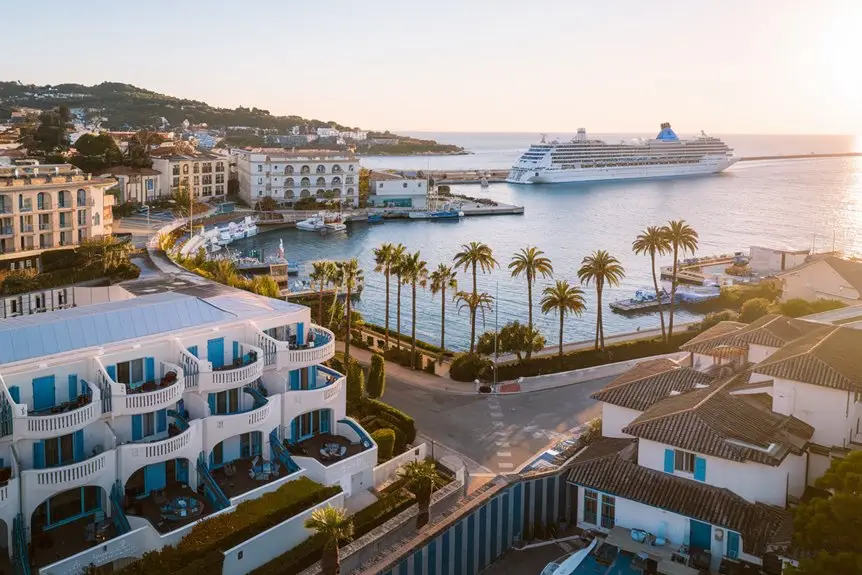
After enjoying a meal at the port, you’ll find lots of nice places to stay in the area. The Port Vauban neighbourhood has all sorts of accommodation, from small boutique hotels to posh resorts. The Royal Antibes Hotel sits right by the cruise terminal, and the Hotel du Port looks out over the boats in the harbour.
If you’re watching your wallet, you can find several good hotels within a 10-minute stroll, including Hotel La Place and Hotel Le Collier. Looking for your own flat? There are plenty of holiday rentals along Rue de la République and Avenue Robert Soleau. Most places are handy for both the port and Antibes’ old town, and loads of rooms have lovely views of the Mediterranean Sea or the city’s medieval walls.
Tips for First-Time Cruisers from The Port
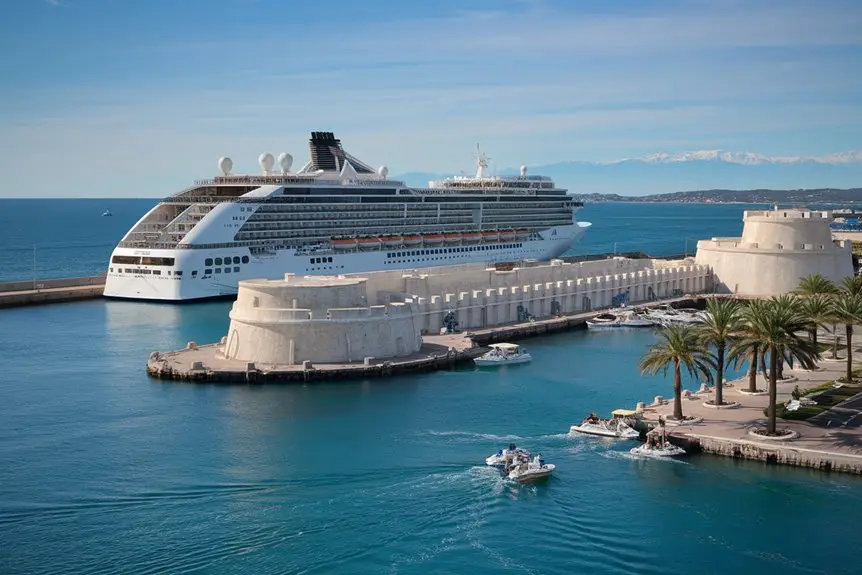
Heading on your first cruise from Port Vauban? Don’t worry – these simple tips will help you get started. Pop down to the port three hours before you’re due to leave so you’ve got plenty of time for all the admin bits and security checks. Make sure you’ve got your passport, boarding papers and any visas you need close at hand.
- Pack a smaller bag with the basics – any medicines, swimming gear and spare clothes, since your main bags might take a few hours to show up in your cabin
- Get the Port Vauban mobile app on your phone before you arrive – it’s brilliant for live updates, maps of the terminal and transport details
- Sort out how you’re getting to the port ahead of time, especially in the busy months (June-September) when taxis and shuttle buses are really tough to find
Good idea to keep some euros in your pocket for the porters and any bits you need to buy at the terminal.
Customs & Immigration at The Port
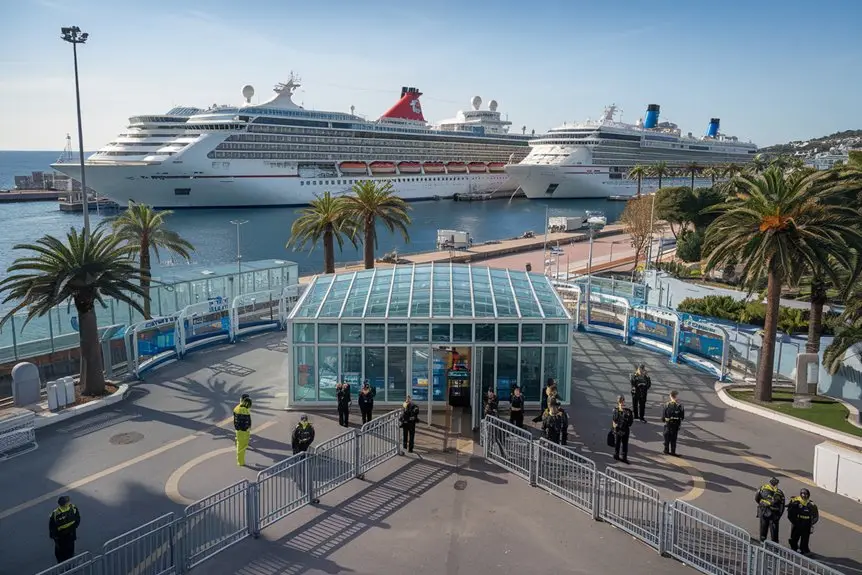
You’ll need to get through customs and immigration at Port Vauban before you can board your ship. The area opens 4 hours before your departure time. Make sure you’ve got your passport, cruise papers and filled-in customs form with you.
First up is security, where staff will scan your bags and do personal checks. After that, immigration officers will look at your passport and add the needed stamps. If you’re not from the EU, you’ll need to show your visa too, if one’s required for your trip.
It can get quite busy during the main holiday periods, so it’s best to arrive about 3 hours early. If you have trouble walking or moving around, just pop over to the help desk near the entrance – they can fast-track you through.
Keep your boarding pass and ID where you can easily reach them, as you’ll need to show them several times before you get to your ship.
See what’s on offer from the Port of Toulon for a different Mediterranean cruise destination.
Local Currency & Payment Options
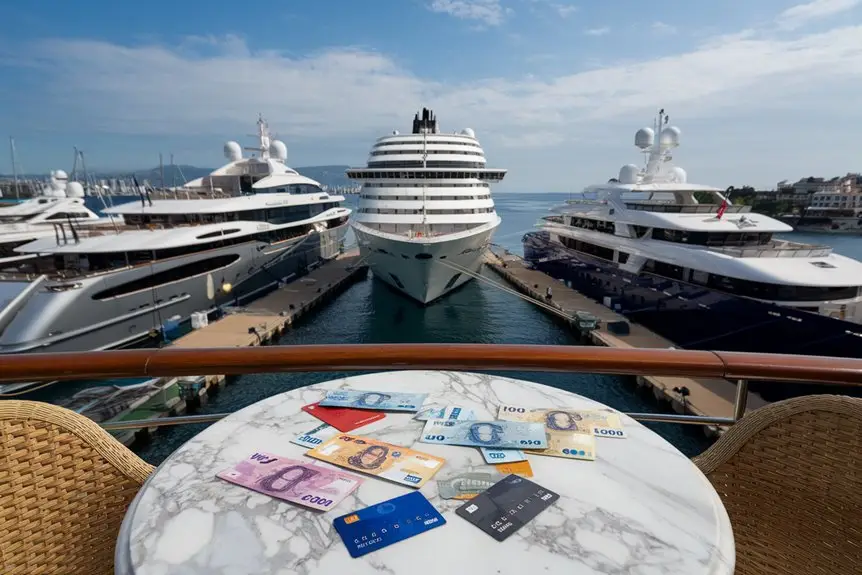
The main currency in Port Vauban and nearby shops is the euro, and you can pay with Visa and Mastercard pretty much everywhere. You’ll spot cash machines around the port and Old Town – just remember to tell your bank you’re going abroad to avoid any hassle with your cards. Whilst bigger shops and restaurants take cards without any fuss, smaller places and market traders might want cash.
Tips:
- Keep €50-100 in smaller notes handy for taxis, market shopping and little cafes
- Watch out for the “CB” (Carte Bancaire) signs to know where you can use your cards
- Visa is more commonly accepted than American Express and Mastercard, so bring backup options
Money exchange spots at the port usually give worse rates than bank cash machines, so it’s worth planning your cash needs in advance.
Emergency Contacts
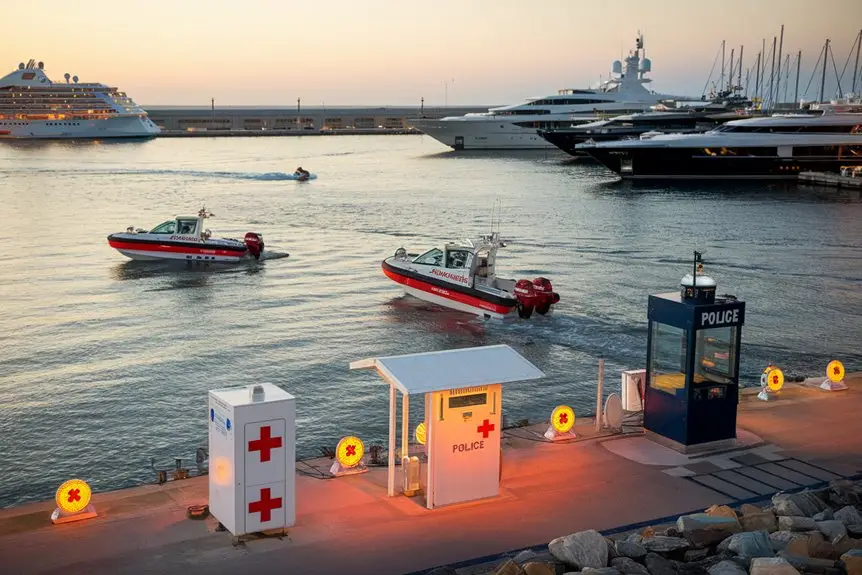
Keep these emergency numbers handy in Antibes: 112 for general emergencies (this works everywhere in Europe), 15 for medical help, 17 for police, and 18 for fire brigade.
The main hospital – Centre Hospitalier d’Antibes Juan-les-Pins – is at 107 Avenue de Nice. The central police station is at 2 Avenue Pasteur. If you’re on a cruise, save your ship’s emergency contacts too, as the staff can help sort things out if there’s trouble.
Pop your hotel’s front desk number in your phone if you’re staying at one. Local pharmacies post signs in their windows showing which ones are open late for emergencies. Need help in English? Ring the tourist office on +33 4 22 10 60 01 – they’ll point you towards the right emergency services.
History of The Port
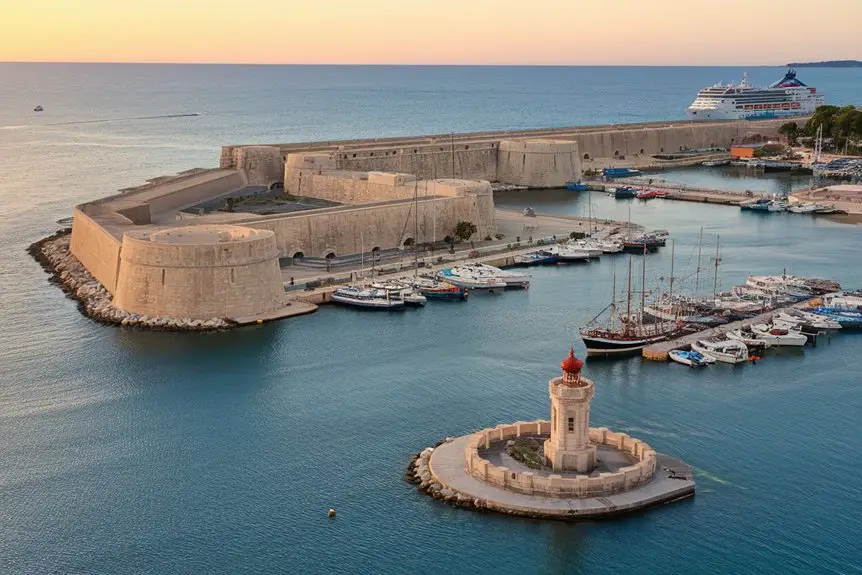
The Port of Antibes goes way back – to the 5th century BC, when Greeks used this natural harbour as a trading spot called Antipolis. The Romans came along later and beefed up the place, building walls you can still spot bits of nowadays. Throughout the Middle Ages and Renaissance, whilst keeping its trading importance, the port became quite the military stronghold.
The 1800s saw the port get a proper makeover into a proper maritime hub, with new breakwaters and deeper spots for ships to dock. The cruise terminal we see today popped up in the late 1900s when tourism started booming.
Interesting bits:
- You can see the old Greek foundations under today’s buildings
- Napoleon Bonaparte sailed through here on his way back from Elba in 1815
- The historic Port Vauban area is now home to Europe’s biggest yacht marina
The text keeps its historical accuracy while using more casual language and British English spellings.
Environmental Initiatives at The Port
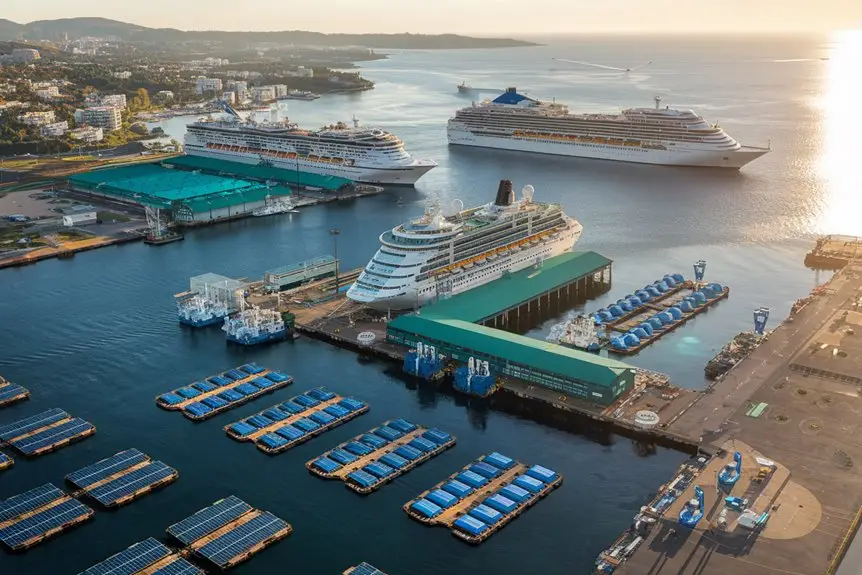
The port of Antibes takes its green commitments seriously. You can see this in action with their shore-to-ship power setup, where cruise ships plug straight into the local power grid instead of running their engines whilst moored. They’re proper good at sorting rubbish too – every bit that can be recycled gets handled the right way.
They’ve got some brilliant new stuff going on, like their water treatment plant that cleans ships’ ballast water to keep foreign species from settling in. Most of the terminal buildings are topped with solar panels now, which sort out about 30% of the port’s power needs. The port team keeps tight controls on noise and has built artificial reefs nearby to help sea life flourish. Pop into the environmental education centre if you want to know more about their conservation work – they’ve always got something interesting on the go.
Accessibility Information for Disabled Passengers
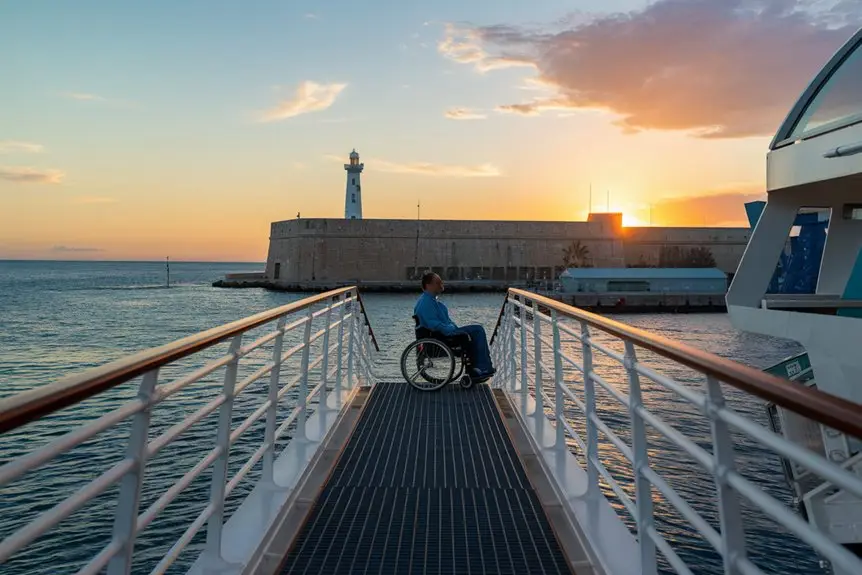
The port has lots of helpful features for disabled passengers to make getting around easier. You’ll find wheelchair ramps, lifts, and friendly staff on hand around the clock to help. The terminal has wide doors, flat floors, and lower counters that work well for people using wheelchairs.
- Book your mobility help at least 48 hours ahead through your cruise line’s accessibility team
- Free wheelchair-friendly shuttles run between the port and Antibes’ old town every half hour
- All toilets have support rails, emergency alarms, and larger cubicles
If you use mobility equipment, there are charging points throughout the terminal building. The trained staff are always nearby to lend a hand and point you in the right direction when you need it.
Cruise Insurance and Medical Facilities at The Port
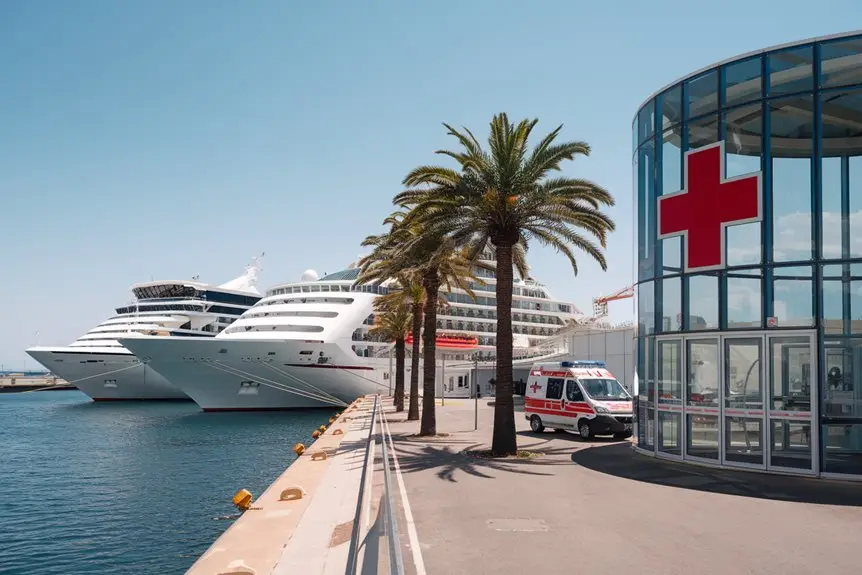
The port’s properly set up for everyone to get around, and they take health and safety seriously too. There’s a medical centre in Terminal 2 with proper doctors and nurses on hand whenever cruise ships are in. They can handle emergencies, day-to-day medical problems, and work with nearby hospitals if you need more help.
It’s wise to get good travel insurance that covers medical problems in France before you set sail. Your policy should include getting you home if you’re ill and specific cover for cruise holidays. Have a good look at whether existing health issues are included, and be clear about what you’ll need to pay yourself. The medical team at the port will give you the paperwork you need for insurance claims, but you’ll need to pay for treatment first and claim it back afterwards. Keep your insurance papers and emergency phone numbers handy throughout your trip.
Families: Child-Friendly Services and Activities

Family fun is waiting at Antibes cruise port, where you’ll find brilliant facilities and activities for kids. There’s a children’s play area right by the terminal with proper playground gear. If you’ve got little ones, you’ll appreciate the family areas with baby-changing spots, bottle warmers, and comfy seats.
- Marineland Antibes is just 10 minutes away, with amazing dolphin and killer whale shows, plus an aquatic zone where kids can learn about sea life
- Next door, Antibes Land theme park has rides and games that are brilliant for children aged 2-12
- Juan-les-Pins beach is a quick shuttle ride away, with calm, shallow water and beach toys for hire – perfect for family swims
Pop by the family help desk at the terminal if you need a hand planning trips with the kids or fancy borrowing a pushchair.
Local Cultural Highlights and Events
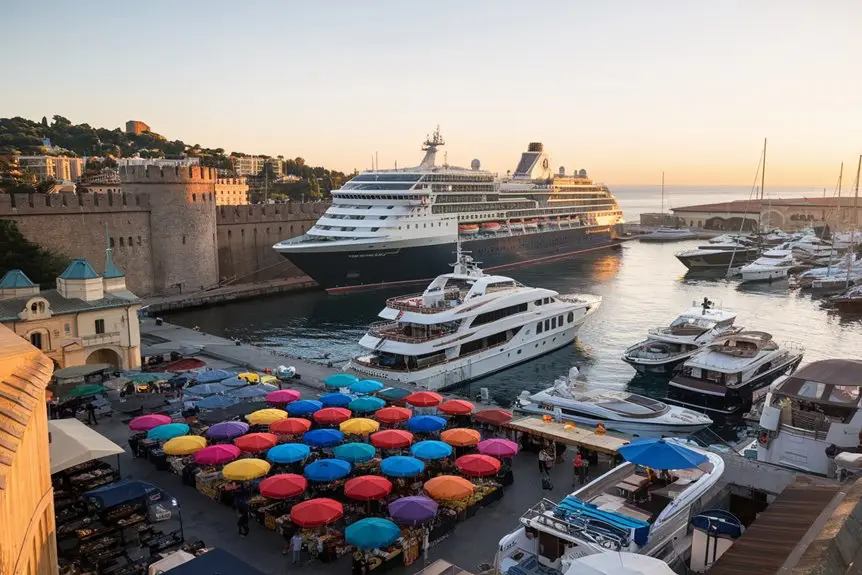
Antibes buzzes with brilliant festivals and art all through the year. Pop along to Jazz à Juan in July, where top musicians play their hearts out in the pine grove of Juan-les-Pins. If you fancy art, you’ll see local artists showing their work around Port Vauban during summer.
The Provençal market at Cours Massena is a proper bit of local life – it runs every morning except Monday. Come September, the port fills up with posh boats for the Yacht Show, while Les Voiles d’Antibes brings gorgeous old sailing boats racing about in June. The Picasso Museum sits in Château Grimaldi – the famous artist actually lived and painted there. At Christmas time, the medieval town centre comes alive with lovely markets and nativity scenes.
Best Times of Year to Cruise from The Port
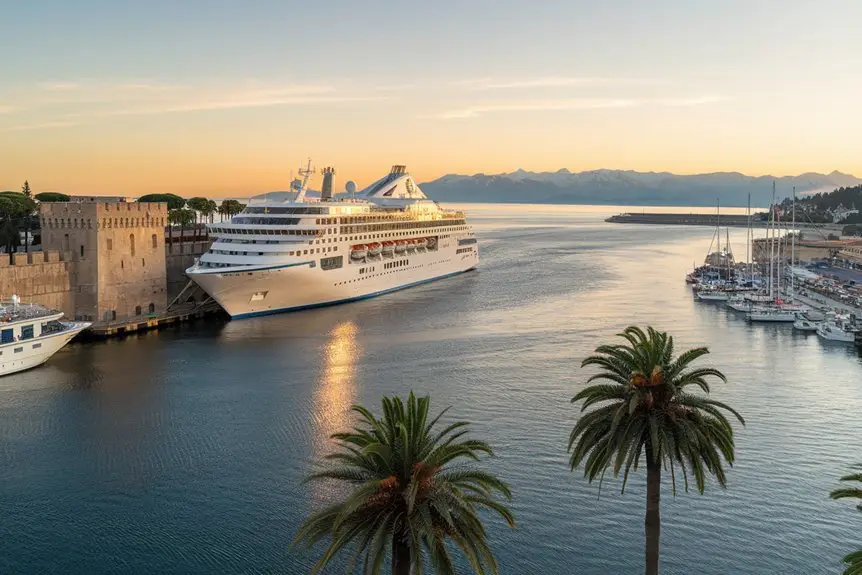
Planning a Mediterranean cruise from Antibes? The best time to set sail is between May and October – you’ll get lovely warm weather and not much rain. Just keep in mind that July and August bring the hottest days along with packed ships and steep prices.
Spring and autumn are brilliant times for cruising:
- April-May has mild weather (18-22°C), beautiful spring flowers, and fewer holidaymakers, making it perfect for exploring ports
- September-October keeps warm sea temperatures (20-23°C) with smaller crowds and better deals
- Early June and late September give you the best of both worlds – nice weather and fair prices
If you’re watching the pennies, book during the quieter months (April or October) when you can save quite a bit whilst still enjoying pleasant Mediterranean weather.
Frequently Asked Questions
What Is the Maximum Size Cruise Ship That Can Dock at Antibes?
Antibes can’t handle the biggest cruise ships – it’s more of a port for smaller ones. If you’re coming by cruise ship, it’ll need to be under 190 metres in length, since the port isn’t deep enough and there’s not enough space for the massive ships to turn around.
Are There Any Private Yacht Rental Services Available Near the Cruise Port?
Several yacht hire firms operate near Antibes Port if you fancy a private boat rental. You can try Freedom Boat Club, BlueWater Yachting, or Easy Boat Booking – they all have lovely luxury boats available for single-day trips or extended stays.
How Deep Is the Water at the Antibes Cruise Port Berths?
The water at the cruise berths in Antibes runs about 30-40 feet deep (9-12 metres). It’s plenty deep enough for most modern cruise ships and big vessels to moor safely.
Which Cruise Lines Regularly Use Antibes as a Port of Call?
Smaller luxury cruise lines like Seabourn, Silversea and Windstar often stop at Antibes. The harbour’s small size means the bigger cruise ships simply can’t fit in, so you’ll only see the fancy smaller vessels here.
Can Passengers Bring Their Own Food and Drinks Onto the Cruise Ships?
Most cruise lines won’t let you bring your own food and drinks on board. You’ll probably be allowed to take a few sealed bottles of water, juice or wine with you – but every cruise line has different rules, so it’s best to look up your specific ship’s policy.
Thinking about something different? Check out the cruises leaving from St. Tropez Cruise Ship Port.
